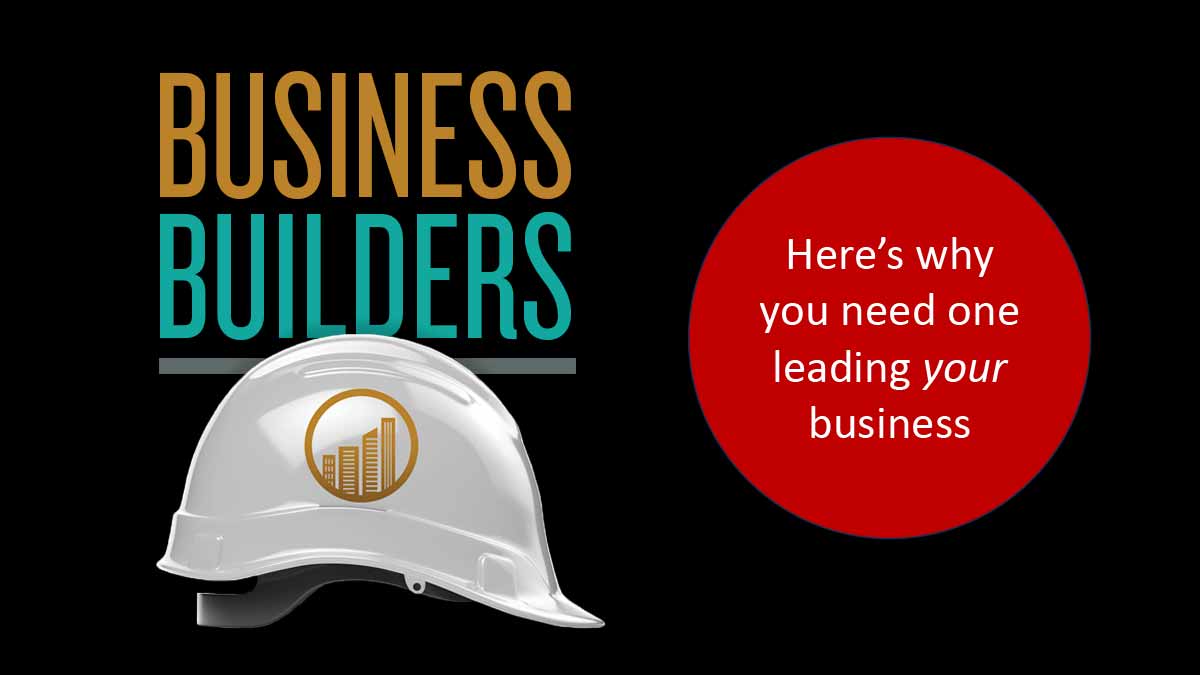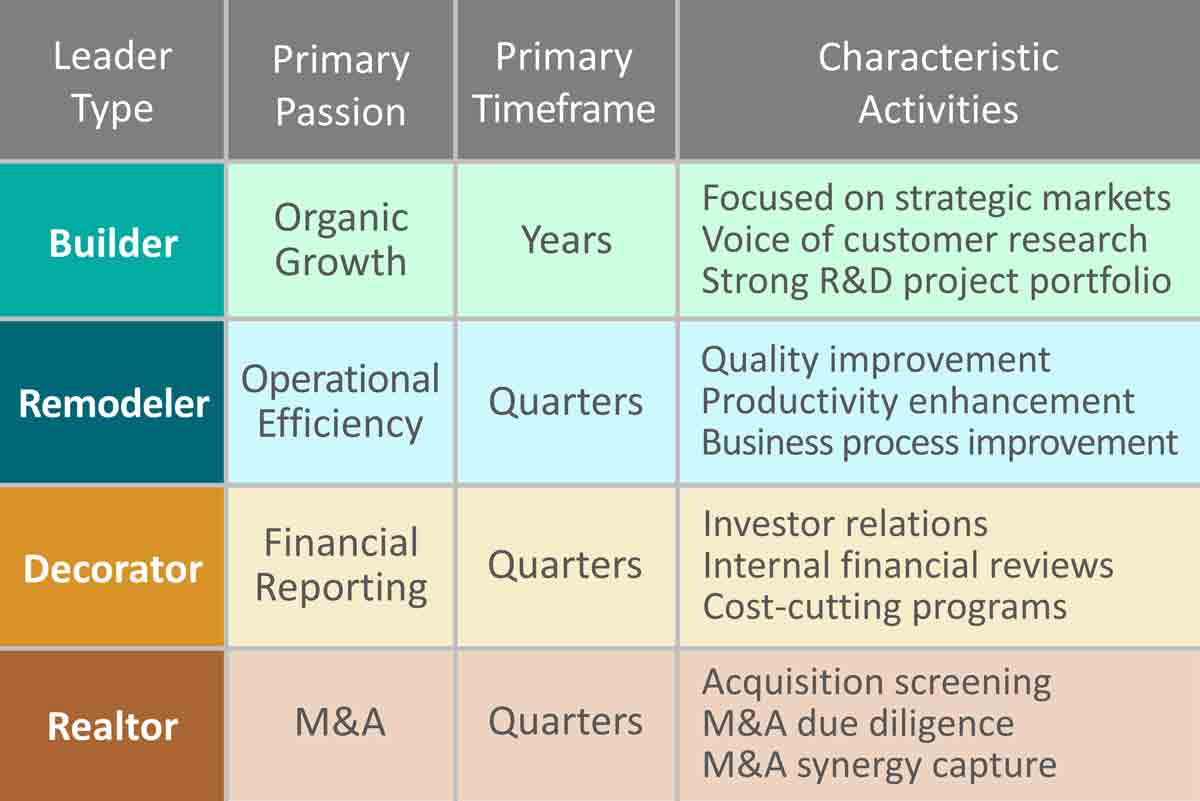Why your senior business leader should be a Builder

Is your business led by a Builder?… a Remodeler?… a Decorator?… a Realtor? New research by the AIM Institute shows your business will be stronger and grow faster if your senior business leader is a Builder. Let’s see why…

On October 30, 2023, we published a new book by Dan Adams: Business Builders: How to Become an Admired and Trusted Corporate Leader. (Free for Amazon Kindle Unlimited subscribers.)
The supporting research came from a survey with 654 responses from senior business leaders, middle managers, and individual contributors. (Many thanks to Gina O-Connor of Babson College for her considerable contributions to the survey design!)
The survey asked about the behaviors of their senior business leaders. To avoid bias in our survey, we didn’t use these four terms: Builder, Remodeler, Decorator, and Realtor. We didn’t think many leaders would cheerfully identify themselves as a Decorator.
Instead, we asked respondents to characterize the primary passion of their senior business leaders using the four descriptions below. We added our four labels after the survey.
- Driving organic growth by delivering differentiated value to customers. (Builder)
- Improving operational efficiency through productivity, quality, and costs. (Remodeler)
- Presenting favorable financial performance and outlook to investors. (Decorator)
- Pursuing external alliances, including mergers and acquisitions. (Realtor)
Not only is the passion different for each senior business leader type; their timeframe is also different. Builders are focused on growing their business stronger over many years, while other leader types generally have shorter time frames.
An Issue with Senior Business Leaders: Not enough BUILDERS
Turns out about half of senior business leaders see themselves as Builders, but only about one-third of subordinates agree that their senior leaders are Builders. Is this a problem? We think so. (Later in this article, you’ll see that Builder behavior correlates with faster business growth.)
A Builder founded your company and every other company. Builders can still be spotted. They drive profitable, sustainable growth by delivering differentiated value to customers, as they brush aside business fads, short-term distractions, and financial gymnastics. Under their leadership, the business grows in size, profitability, and stature.
Builders drive profitable, sustainable growth by delivering differentiated value to customers.
Builders don’t see their retirement as the “finish line,” but rather as the time when they pass a baton on to the next leader. Their motto is, “Leave your business stronger than you found it.”
But not every company is still led by Builders. Today, many senior business leaders are Remodelers, Decorators, or Realtors.
What is a REMODELER?
Remodelers are forever fixing the place up. They may work on improving quality, boosting productivity, or eliminating wasteful costs. These are commendable endeavors, but if nothing new is built, the company reaps diminishing returns.
Imagine you’ve been working on quality improvements. Good! But what will you do after you get to zero defects? Perhaps you’re driving down labor costs and you’ve finally reached full automation with a lights-out factory. Your productivity is fantastic, but what will you do next? You’ve reached diminishing returns.
Remodeling is good, but Remodeling without Building is a race to the bottom that ends in commoditization. Your competitors eventually match your quality or productivity with similar products. Now the price wars begin.
Remodeling without Building is a race to the bottom that ends in commoditization.
What is a DECORATOR?
Decorators are always trying to boost “curb appeal.” They’re focused on how the place looks, and life is all about the quarterly financial report.
Decorators think they’re doing meaningful work, but they aren’t really making a difference. The energy they put into this quarter’s financial report is squandered energy. Next year, no one will even remember that quarter that seemed so important at the time.
Like Remodeling, there’s nothing wrong with Decorating in itself: Why not look good to investors? The problem arises when Decorating occurs at the expense of Building. It very often does if senior business leaders are Decorators: their many short-term actions degrade long-term profitable growth.
You see, Decorators are engaged in a spectator sport, not a participant sport. The only way to change a quarterly financial report in a healthy way—with sustainable revenue growth, premium pricing, and impressive profit margins—is to conduct strong Building in the years prior to the financial report. That’s the time to create new products and services customers love… and for which they will pay premium pricing.

Decorators play the lead role in a business version of the movie, “Groundhog Day.” After each financial reporting period, they begin the same activities all over again. Their business hasn’t fundamentally changed. In fact, Decorators play a rather depressing version of Groundhog Day: Bill Murray’s character at least used all those repetitions to build a better version of himself.
What is a REALTOR?
Realtors love to buy and sell, reaping their rewards during mergers and acquisitions. Realtors are rewarded when the hard work of others’ hands is transferred into their hands. Realtors mostly redistribute wealth that others have created.
Research shows 70–90 percent of acquisitions fail. But some can be helpful, especially when acquiring a key competency that helps a business change its growth trajectory. When your senior business leader is a Builder, the acquired business can become an important building block in her building program.
A frequent rationale for acquisitions is to improve current operations through anticipated synergies. The problem with many Realtors is that they don’t know how to grow what they acquire. Their acquisitions become enormous distractions from the Builder’s work needed for organic growth. As a result, many Realtors are just building a house of cards.

Builders drive faster business growth
Does this mean a senior business leader should forget about operational efficiency, financial reporting, or M&A? Of course not. But what is their passion? What gets them excited about their job? For the Builder, it’s driving profitable, sustainable organic growth by delivering differentiated value to customers.
Until this new research, one might argue there’s no advantage in a senior business leader behaving as one type over another. But now we see a strong correlation between (a) senior business leaders exhibiting Builder behavior and (b) stronger growth. Among companies growing faster than competitors, the most frequent business goal is to grow by meeting customer needs—a Builder trait. Among slower-growth companies, the most popular business goal is maximizing shareholder wealth—a Decorator characteristic.

As the book explains, slower-growth companies also employ more near-term cost controls, such as spending freezes, travel bans, hiring delays, and layoffs (chapter 7). The senior business leaders of slower-growth companies are also much more focused on near-term results, not capability building (chapter 9).
Senior Business Leaders: Are you a Business Builder?

You don’t have to be a senior business leader to be a Business Builder. In fact, if you wait until then to develop the experience and mindset… you’ll probably be too late. Business Building is hard work and is done best by those with strong convictions.
You can take this free 5-minute assessment to see how well your beliefs align with those of Business Builders.
You can download a confidential report with your overall Business Builder Score (100 max), and explanations of the 20 Business Builder beliefs behind each assessment question.
Will you help?
Want to be part of a movement where senior business leaders put the well-being of their company and employees before Wall Street share handlers? Where corporate leaders behave like the founders of their company? Here are two ways you can help “spread the word”:
- Leave an Amazon review at ReviewBusinessBuilders.com.
- Would you leave a LinkedIn post telling others about this book? Here’s a book cover photo you can include.


Comments